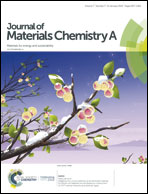Rocking-chair Na-ion hybrid capacitor: a high energy/power system based on Na3V2O2(PO4)2F@PEDOT core–shell nanorods†
Abstract
The Na-ion hybrid capacitor (NIC) has exhibited its potential applications for devices that need high energy and power densities with low cost. Nevertheless, due to their “Daniell-type” mechanism, conventional NIC devices require massive electrolytes to provide a good ionic conductivity during charging, which could decrease the packaged energy density. Herein, we report a novel “Rocking-Chair” Na-ion hybrid capacitor (RC-NIC) employing Na-ions as charge carriers, Na3V2O2(PO4)2F@PEDOT as the cathode material and activated carbon (AC) as the anode material. RC-NIC efficiently improves the energy density by minimizing the amount of electrolyte like secondary batteries because Na-ion is de-intercalated from the cathode while it is adsorbed to the anode during charging. The Na3V2O2(PO4)2F@PEDOT//AC (peanut shell derived carbon) RC-NIC delivers high energy density of ∼158 W h kg−1 and power density of ∼7000 W kg−1 based on the total mass of active materials in both electrodes, respectively, in the voltage window of 1.0–4.2 V. This is one of the highest energy densities among the previously reported NICs. This concept provides a new route to build sodium-ion hybrid capacitors that meet dual criteria of battery and supercapacitor characters.



 Please wait while we load your content...
Please wait while we load your content...